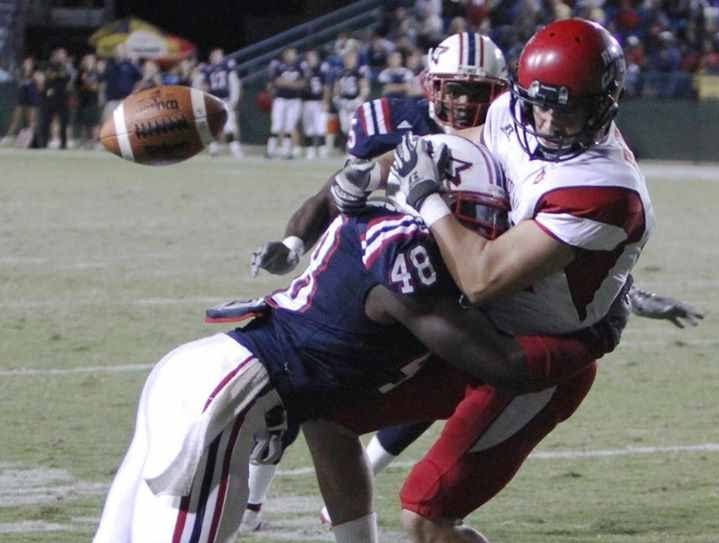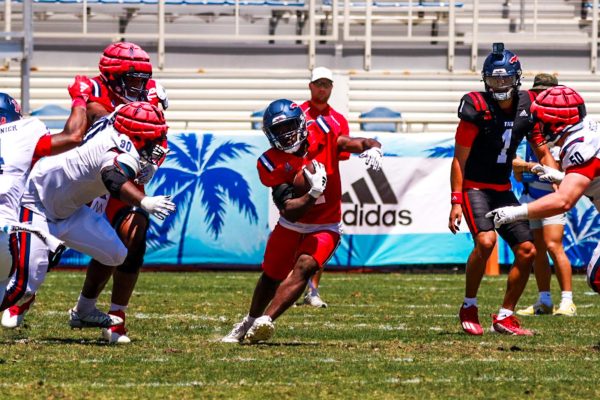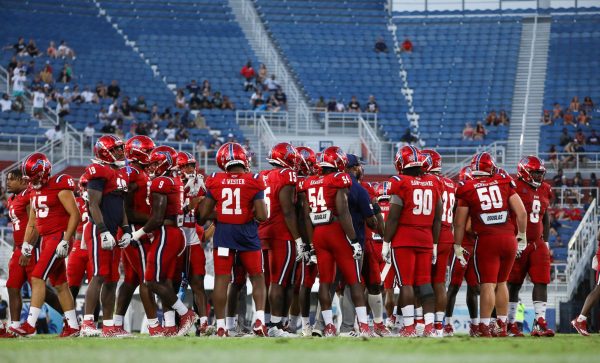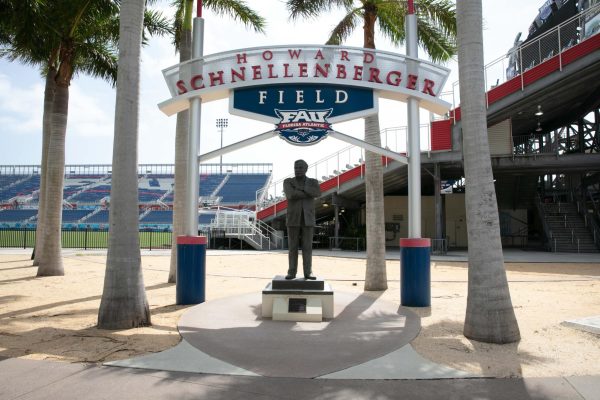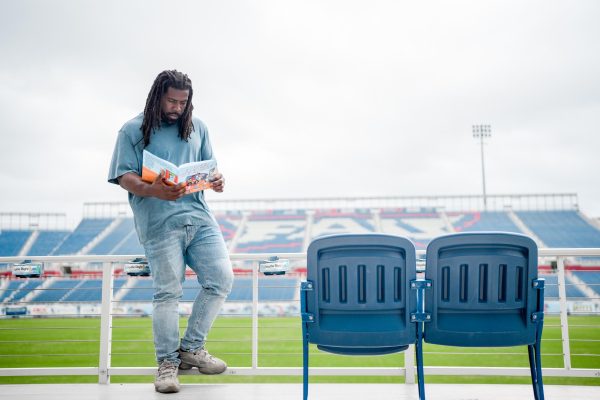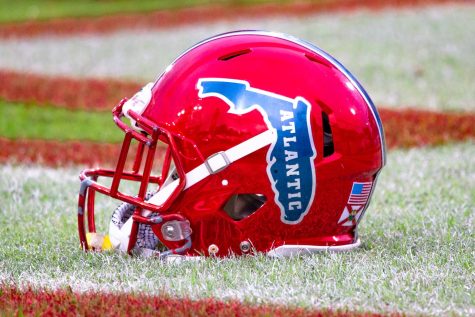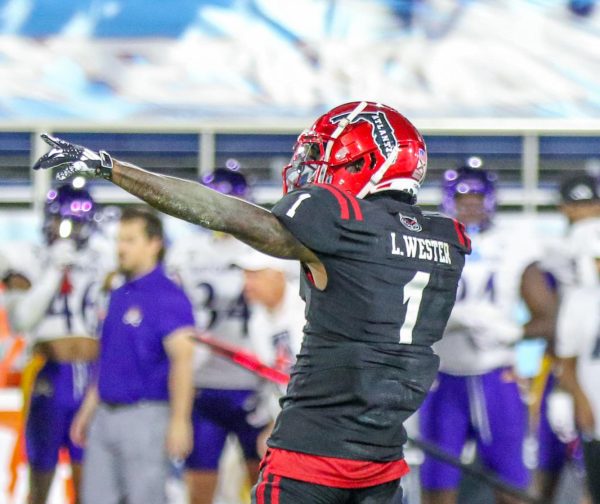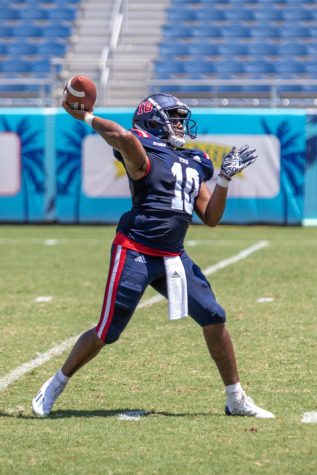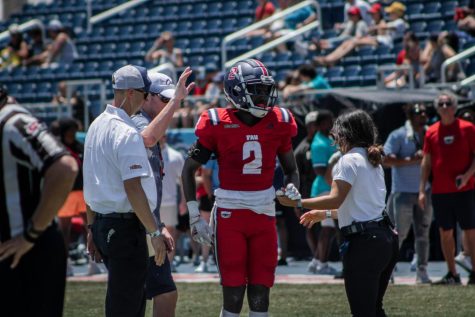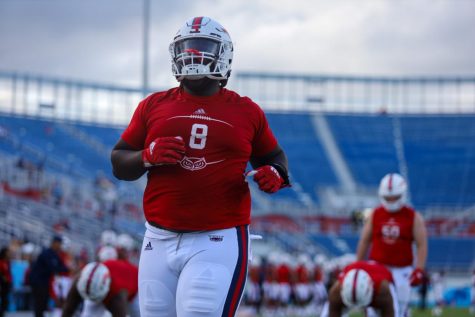‘These white spots shouldn’t be here’: Former athletes, experts detail head trauma complications
Experts assert that university athletics’ concussion procedures are complicated by multiple competing factors. Former FAU linebacker Yourhighness Morgan explains how repeated head injuries changed his life.
May 16, 2023
In just two years, former FAU linebacker Yourhighness Morgan suffered five documented concussions. Coming off of a successful four-year career as a quarterback at South Sumter High School in Webster, Fla., Morgan joined the Owls with the intent of eventually entering the National Football League (NFL).
A concussion cut short his time on the field in 2011 and forced him to withdraw from all his classes that semester. Later, a Cleveland Clinic physician underscored the harsh reality of his invisible injury, refusing to authorize Morgan to play again.
“He showed me that there were these white spots on what’s called the frontal lobe,” Morgan recalled. “He was like, ‘these white spots shouldn’t be here for someone your age.’ I was maybe 21 or 22 at the time.”
Morgan insisted on getting the opinion of four or five more doctors, but the verdict remained the same — his career as a football player was over.
Morgan is not the only person associated with the university to deal with concussion issues. Former running back Daniel Leconte missed playing time in 2019 with one.
Safety Winfred Strickland saw his career end due to repeated concussions. So did former FAU football coach Clint Trickett. Now coaching at Marshall, Trickett did not respond to multiple requests for comment by publication time.
FAU Athletics Department representatives declined to make current student-athletes available for this story, citing student and medical privacy laws. Dr. Jason Perry, the department’s medical director and head team physician, initially agreed to an interview but did not respond to a set of emailed interview questions for this story.
Doctors have identified changes in the behavior of athletes subject to repeated head injuries as early as the 1920s. Dr Bennet Omalu, a Nigerian pathologist, was the first to publish evidence of the neurological condition in American football players, which he named chronic traumatic encephalopathy (CTE).
Omalu’s discovery of CTE — a life-altering brain disease resulting from repeated blows to the head — propelled concerns of long-term brain injury to the forefront of sports conversation.
Experts see an inherent tension for physicians who work with college teams. Brandon Boyd, education programs manager at the Delaware-based Concussion Legacy Foundation, feels university personnel are much more likely to put a star player back in prematurely, in the team’s interest.
“College medical staff, what logo do they have on their shirt? It’s not independent, it’s Florida Atlantic,” Boyd said.
CTE
Dr. Omalu and Dr. Julian Bailes discovered the first condition of CTE in 2002 through the post-mortem brain examination of former Pittsburgh Steeler Mike Webster.
Symptoms include dementia-like behaviors that debilitate former athletes, causing premature decline in functioning. Health professionals may identify signs that point towards CTE through changes in behavior or functioning, but can only make an official diagnosis post mortem through the analysis of brain tissue.
“Technically speaking, you cannot confirm a diagnosis of CTE until you do a brain autopsy but you can obviously very strongly suspect it,” said FAU team psychologist and certified neuropsychologist Raphi Wald.
CTE diagnoses are largely defined by an excessive buildup of tau protein in the brain.
Symptoms include executive dysfunction, muscle movement disorders, mood disorders, memory disorders, and — in extreme cases — changes in personality.
“With CTE you get, very often, degenerative dementia problems with memory and other thinking skills,” Wald said, adding that the disease progressively gets worse over time.
“With a number of head traumas you get depression, anxiety, anger, memory loss, aphasia, executive dysfunction, all kinds of different issues, poor judgment included,” he said.
In hindsight, Morgan appreciates that a team physician made the decision that they did with his health in mind.
“I didn’t necessarily agree with it then. Now looking back, do I feel like it was the right call? I probably feel like it was, but deep down I still wanted that shot.”
Morgan now coaches at his former highschool, South Sumter. He explains that during his time at FAU most of his injuries were the result of hits in scrimmages and practices, which he tries to avoid with his own players.
“I let them know my experience and I kind of watch them closely,” he said. “As much as possible during the practice period I try to not set them up for failure. I try to just keep them safe in some of the drills we do and not have them hit as much and just save it for game time.”
Complications to Athletes’ Reporting
A collection of competing factors including socio-economic status, individual attitude, social expectations, and team pressures can influence an athlete’s choice to report an injury.
“They don’t want to lose their playing time, they don’t want to appear weak, they don’t want to miss a big game, all of those things matter to athletes,” Boyd said.
Symptoms typically worsen with each concussion, making them difficult to diagnose early if athletes do not come forward.
“I never checked myself out of a game, I never went to coach or to a trainer and said ‘hey something is wrong,’” Morgan said. “If my legs looked like they weren’t underneath me, almost like a boxer, they would go from there and start what they called concussion protocol.”
Billy Hawkins, a sociology professor at the University of Houston and a former collegiate athlete, said social expectations, race, and revenue all factor into injury reporting.
He explained that many college athletes coming from working and lower-class homes are hopeful for a career in the sport as a means of social mobility.
In many cases, Hawkins say, family members see the student-athlete as their ticket out of a difficult financial situation which may encourage them to continue playing.
“There’s pressure from family. Your family is expecting to see you make it to the next level, they’re seeing it as a win for them too, so there’s that pressure that’s placed on athletes especially when they are seen as the ticket out for generations to follow,” Hawkins said.
The “no pain, no gain” mentality can also be especially harmful, Hawkins said.
“When you’re in a sport where there’s a premium on masculinity, you’re going to adhere to those ideals associated with masculinity– one of them is not succumbing to pain,” he said.
Morgan reflected on the team’s culture around injury reporting saying, “probably in the group that I played in we looked at it as being soft back in the day.”
He expressed initial disappointment in himself for coming up short on personal, team, and family goals he had set.
“With all the goals I had in mind, I wanted to keep playing,” Morgan recalled.
Oftentimes collegiate athletes’ identity becomes tied to the sport they play. Their closest circle are those who are on the team, separation from their sport and peer group for the duration of the recovery period can be very difficult.
“There’s also the actual life stressor that occurs when you have this built-in group of friends that are your closest friends on the planet and all of a sudden you are taken out of that group and you can’t be with them the way that you want to be,” Wald said.
Morgan found himself isolated from some of the people closest to him, and eventually depressed.
“I gotta wait on them to get out of film sessions, I gotta wait on them to get out of weights, I gotta wait on them to do this, and it was like man, I gotta find a whole new identity,” Morgan said.“It wasn’t nothing easy about it, it definitely was tough, it was depression.”
Conflict of interest
Ultimately, student-athletes may not be in the ideal position to be trusted to come forward with injuries, but staff in the athletic department may also discourage players from reporting or undermine the process.
Athletic medical staff are oftentimes employed by or contracted with the university. By contrast, the NFL utilizes independent medical consultants in hopes of ensuring athletes receive honest assessments free of external pressures or conflicting interests.
“[College medical staff] are employees of that institution and so their job is to support the institution and the athletic program, so that can create complications,” Boyd said. “Trainers are amazing. Medical staff, the things that they do to help athletes recover and protect their health is amazing, but those interests are there and can create problems for sure.”
Professional leagues have independent spotters and evaluators who decide when athletes are safe to return to the game. The process of assessing players injuries and making decisions to put in or pull out athletes is not an independent process in college.
“One of our coaches used to tell us, before we go see the trainer we need to come see him and he’ll tell us if we’re hurt or not,” Morgan explained, declining to specify further.
When external bodies of physicians and healthcare personnel analyze athletes’ wellness they may provide a more accurate and unbiased diagnosis.
Hawkins, the University of Houston professor, agreed with Boyd: “When you talk about the diagnosis, prognosis, all of that. They are much more loyal to the University, the team,” he said.
Privacy laws
Since the discovery of CTE and its association with contact sports like football, the NCAA has required schools to implement updated concussion protocol, but has not required that this process include outside entities or that injury reporting be a public process.
Privacy laws, namely the Health Insurance Portability and Accountability Act and the Federal Educational Records Privacy Act, have been used as the primary defense against publicizing student athlete’s medical records and health information, making it difficult for outside entities to hold teams accountable.
In 2011, Gators wide receiver Trey Burton was injured in the teams season opener against the Owls. The then coach at the University of Florida, Will Muschamp, responded vaguely to reporters from the Florida Times-Union inquiring on the nature of the injuries sustained by Burton. Muschamp did so well within his rights.
Unlike the NFL, the NCAA does not compel coaches to fulfill any mandatory injury report requirements citing student privacy laws.
Under the very same reasoning, college personnel conceal records of head injury from outside entities such as the media.
In May 2018, Murphy v. NCAA, the Supreme Court of the United States overturned a 1992 congressional decision that passed the Professional and Amateur Sports Protection Act which prohibited sports gambling.
Later that same month, the National Athletic Trainers Association issued an official statement in favor of adopting standard injury reporting in response to the Supreme Court’s decision to legalize sports betting for college athletics.
The discussion raised controversy as to whether sports betting would negatively impact student athletes and if students’ confidentiality could be respected in the injury reporting process.
In a webinar hosted by Lead1, an organization that represents many athletics directors in the NCAA, panelists discussed the implications of legalized sports betting. Lead1 summarized the sentiment of Heather Lyke, Director of Athletics at the University of Pittsburgh, in the following statement:
“The introduction of legal wagering on college sports will have a detrimental impact on student-athletes and general student bodies. Lyke described the temptations that student-athletes face due to intense community pressures, which would be exacerbated if wagering takes place.”
Racial biases
University of Virginia authors published an article in 2016 claiming white people are much more likely to disparage the pain of Black patients.
“Physicians were more likely to underestimate the pain of Black patients (47%) relative to nonblack patients (33.5%),” reads the study.
Even today, longstanding stereotypes of Black men being better athletes support the notion that they are impervious to pain.
“In fact, many people insist that Black people are better athletes — stronger, faster, and more agile — as a result of natural selection and deliberate breeding practices during slavery,” the authors explained.
Concerns of health professionals’ biases towards Black student-athletes concerns Hawkins, who has both played and worked at predominantly white institutions.
“There is an assumption that the thresholds of pain for Black people are much higher so there’s this expectation that if we’re suffering, it’s something that we can work through as Black males, opposed to a much more accurate diagnosis,” Hawkins said.
Hawkins urges campus communities to understand that athletics personnel are concerned not only with the well-being of student-athletes but also with the business end of the team.
“There’s multiple types of layers to this culture that exist in athletics and again the most important one was the premium on commercialization,” Hawkins said. “This idea in revenue generating sports, there’s an economic demand for your athletic talent so definitely at the professional level, you’re gonna work through some pain or not mention that.”
Jasmine Die is the former Copy Desk Chief of the University Press. For more information regarding this or other stories, email [email protected].

